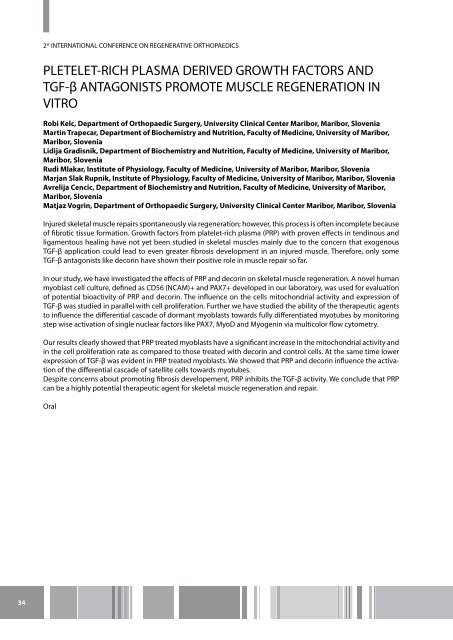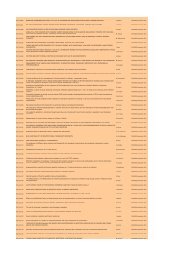Profilaksa DVT kod velikih ortopedskih operacija - Depol ...
Profilaksa DVT kod velikih ortopedskih operacija - Depol ...
Profilaksa DVT kod velikih ortopedskih operacija - Depol ...
Create successful ePaper yourself
Turn your PDF publications into a flip-book with our unique Google optimized e-Paper software.
34<br />
2 st INTERNATIONAL CONFERENCE ON REGENERATIVE ORTHOPAEDICS<br />
PLETELET-RICH PLASMA DERIVED GROWTH FACTORS AND<br />
TGF-β ANTAGONISTS PROMOTE MUSCLE REGENERATION IN<br />
VITRO<br />
Robi Kelc, Department of Orthopaedic Surgery, University Clinical Center Maribor, Maribor, Slovenia<br />
Martin Trapecar, Department of Biochemistry and Nutrition, Faculty of Medicine, University of Maribor,<br />
Maribor, Slovenia<br />
Lidija Gradisnik, Department of Biochemistry and Nutrition, Faculty of Medicine, University of Maribor,<br />
Maribor, Slovenia<br />
Rudi Mlakar, Institute of Physiology, Faculty of Medicine, University of Maribor, Maribor, Slovenia<br />
Marjan Slak Rupnik, Institute of Physiology, Faculty of Medicine, University of Maribor, Maribor, Slovenia<br />
Avrelija Cencic, Department of Biochemistry and Nutrition, Faculty of Medicine, University of Maribor,<br />
Maribor, Slovenia<br />
Matjaz Vogrin, Department of Orthopaedic Surgery, University Clinical Center Maribor, Maribor, Slovenia<br />
Injured skeletal muscle repairs spontaneously via regeneration; however, this process is often incomplete because<br />
of fibrotic tissue formation. Growth factors from platelet-rich plasma (PRP) with proven effects in tendinous and<br />
ligamentous healing have not yet been studied in skeletal muscles mainly due to the concern that exogenous<br />
TGF-β application could lead to even greater fibrosis development in an injured muscle. Therefore, only some<br />
TGF-β antagonists like decorin have shown their positive role in muscle repair so far.<br />
In our study, we have investigated the effects of PRP and decorin on skeletal muscle regeneration. A novel human<br />
myoblast cell culture, defined as CD56 (NCAM)+ and PAX7+ developed in our laboratory, was used for evaluation<br />
of potential bioactivity of PRP and decorin. The influence on the cells mitochondrial activity and expression of<br />
TGF-β was studied in parallel with cell proliferation. Further we have studied the ability of the therapeutic agents<br />
to influence the differential cascade of dormant myoblasts towards fully differentiated myotubes by monitoring<br />
step wise activation of single nuclear factors like PAX7, MyoD and Myogenin via multicolor flow cytometry.<br />
Our results clearly showed that PRP treated myoblasts have a significant increase in the mitochondrial activity and<br />
in the cell proliferation rate as compared to those treated with decorin and control cells. At the same time lower<br />
expression of TGF-β was evident in PRP treated myoblasts. We showed that PRP and decorin influence the activation<br />
of the differential cascade of satellite cells towards myotubes.<br />
Despite concerns about promoting fibrosis developement, PRP inhibits the TGF-β activity. We conclude that PRP<br />
can be a highly potential therapeutic agent for skeletal muscle regeneration and repair.<br />
Oral




